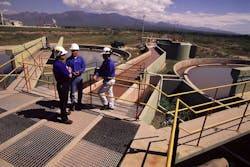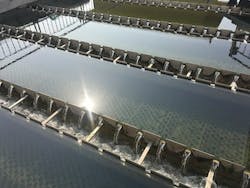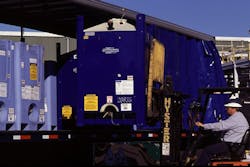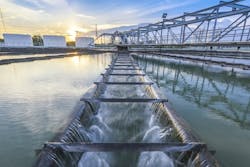Water Treatment Chemical Storage & Management Best Practices
About the author:
Larry Smith is senior engineer of customer application engineering for Suez - Water Technologies & Solutions. Smith can be reached at [email protected].
Surface water treatment for use within industrial facilities and wastewater treatment often requires chemicals to remove contaminants. Many decisions regarding the chemicals used, like how they are properly stored on-site and the treatment program management, need to be made. This article will discuss some key factors commonly used in treatment program development.
Water & Wastewater Chemical Treatment
In both surface water clarification and wastewater treatment, depending on the contaminants present, coagulants, and as needed, flocculants are commonly used for most industries.
These two broad product classifications vary widely in composition, charge density, molecular weight and function. The breadth of a supplier’s portfolio should be considered when evaluating treatment options. Through proper pre-screening, the right treatment dosages are determined to meet treatment goals. These goals vary widely and are site-specific based on water quality needs. From initial bench testing, on-system evaluations occur that confirm the screening results and determine longer-term results and the cost to treat.
Suez – Water Technologies & Solutions’ portfolio of KlarAid coagulants, as well as PolyFloc and Novus flocculants, are used globally in industrial water and wastewater treatment programs. These coagulants react with total suspended solids (TSS) and emulsified oil and grease (if present) to form larger, discrete suspended solids or oil droplets, respectively.
From this reaction, the contaminants can more easily be removed with the equipment used in a system, be it a clarifier, dissolved air flotation (DAF) unit or filtration. Flocculants bridge the coagulated and raw water TSS to aid in faster removal via gravity settling or flotation, dependent on the treatment system equipment used.
Coagulant Best Practices
Coagulants vary in chemistry type, and many, but not all, are relatively low viscosity and easy to pump with standard chemical metering pumps. Some coagulants are much higher viscosity requiring specialized pumps to ensure proper dosing occurs. The right coagulant product/chemistry must be chosen to meet the treatment goals as part of program development. The product's characteristics must be reviewed regarding feed and chemical storage needs.
Product characteristics such as viscosity, pour and freeze point temperatures, and chemical compatibility with a storage container, as well as feed and conveyance equipment, are important considerations. Product Safety Data Sheets (SDS) often have some of this information, but the end-user needs to work with the product supplier to ensure these factors are reviewed before implementing a program.
At times, a coagulant program may need to be changed due to changes in water composition. In that case, the new product may be under consideration to be stored in the same container or tank as the product being replaced. Care must be taken to confirm if both coagulants are compatible or if full removal of existing product residual and container rinsing is needed. Container clean out may be required and supplier guidelines should be followed. Coagulants often cannot be mixed, even if similar chemistry.
Flocculant Best Practices
If flocculants are used in the treatment program, many of the coagulant feed and storage equipment compatibility concerns noted above also apply.
If the use of a tote, drum or pail of coagulant or flocculant is the normal container size used, instead of a larger bulk tank, and there is no chance of co-mingling of old versus replacement products, the concerns over container clean out usually is not an issue.
Common Forms of Flocculants for Water & Wastewater
Flocculants come in several forms, each of which has its own unique storage and handling needs to ensure it is optimally used. Flocculants sold to industrial applications include liquid emulsions, powders, solutions and dispersions. Some key reminders on the storage and handling of each are summarized below.
Emulsion flocculants
Emulsion flocculants by design are a blend of water, oil and polymer that must be stored properly and routinely mixed to ensure oil and polymer separation is eliminated and a homogeneous product is maintained. Mixing of container contents is a key consideration. Avoiding any external water contamination and minimizing the potential for water condensation inside containers must be adhered to.
Gelling and possibly plugging of feed equipment can occur if these products are exposed to external moisture and are not handled and stored correctly. Freeze protection and avoiding exposure to high temperatures in storage must be ensured to avoid issues.
The right type of activation system (dilution) of these products is also important in treatment design. Without using the right make-down and feed equipment, the product is inefficiently used, often higher than needed use rates occur, and the product is wasted with the end user not getting the full benefit for the purchase. As with coagulants, the proper materials of compatibility for feeding flocculants must be adhered to, and feed pumps and conveying piping choices are essential.
Powder flocculants
Powder flocculants are another option when considering the use of a flocculant. Storage conditions to avoid moisture contamination is critical. Moisture contacting the powder product will cause caking or even gelling, rendering the product useless. Bags, drums, and in large applications, super sack quantities of product are used. In all cases, proper storage conditions must be followed.
These products require activation to a working solution prior to treatment, and proper addition of powder to the water in batch mixing is needed. The make-down system is an important aspect of using dry flocculants and needs to be designed properly to get the most benefit from the product purchased.
Specialized dry feed equipment using product storage hoppers with powder feeders are part of systems various manufacturers offer. The use of mix tanks (with mixers), a holding tank for each batch created, and a dry flocculant educator to properly convey the powder into the mix water is another method used when a more manual approach to make down is done.
Solution flocculants
In some cases, solution (non-emulsion/non-powder) flocculants are used and offer a convenient way to purchase and use a flocculant. Often no further activation or make-down is needed, but these can be viscous and proper feed pump selection is needed to ensure smooth operation. Avoiding freezing of the product is important too.
Dispersion flocculants
These products need to be handled similarly to an emulsion flocculant, but making down and dilution before injection to a system is not as stringent as that of an emulsion product. The supplier’s recommendations for applying such products must be followed if considering these types of products.
Other Considerations
Following supplier SDS guidelines and the end user’s Environmental Health and Safety (EHS) policies on where and how to store coagulant or flocculant products at the user’s facility must be reviewed. The purchaser and/or end-user of these products will often have their own company guidelines that may also include government regulations.
Inventory Management
Inventory management of coagulants and flocculants is important to ensure no chance of product run out occurs that may end up requiring reducing water flow through the system being treated, temporary curtailment of all water treatment, or worst-case scenario, affecting the production of whatever is being manufactured. Routinely checking the inventory of any product is a commonsense way to avoid this, but sometimes it is not followed as well as it should be.
One aspect of inventory management when tanks of liquid coagulants and flocculants are used is to implement tank level sensors when setting up a program. This has been successfully done for many years. Sensor readings help keep track of use rates and inventory and are often set up to alert end-user personnel and product supplier representatives to ensure time to reorder the product.
Identify Product Use Rates
One other important consideration involves how much product to order. Estimated use rates based on real-time product use during evaluations on any system will provide expected use rates. The longer a program is used on a system, the more accurate the use rate projections. Products should be ordered to have enough on hand in case inlet water conditions change that may drive up use rates. Full-service suppliers work closely with customers to ensure the right amount of product is ordered.
In conclusion, coagulants and flocculants are commonly used to treat surface water and wastewater in various industries. Understanding how each product used should be stored, handled, and applied is important to ensure the best treatment outcome. Following the key recommendations in this article can help realize the full benefits of a properly chosen treatment program.



